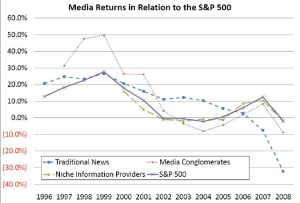Everybody’s looking for the magic formula. What, pray tell, is the business model that will keep independent journalism alive? A new report to be unveiled tomorrow at a Yale University conference has some suggestions, along with a fair amount of scary data about the current state of the news business.
“The News Landscape in 2014: Transformed or Diminished? Formulating a Game Plan for Survival in the Digital Age” is co-authored by Penelope Muse Abernathy of UNC’s J-school and Richard Foster of Yale’s School of Management. They look at what’s happened to media companies since the rise of the Web in the mid-1990s, and the picture isn’t pretty.
 Shareholder returns for traditional media companies have been dropping since 1999. Media conglomerates have done somewhat better. But the only companies that have really kept up with the S&P are what the authors call “niche” providers–such as Thomson Reuters, McGraw Hill, and Reed Elsevier [the company behind LexisNexis]–that serve business and professional markets.
Shareholder returns for traditional media companies have been dropping since 1999. Media conglomerates have done somewhat better. But the only companies that have really kept up with the S&P are what the authors call “niche” providers–such as Thomson Reuters, McGraw Hill, and Reed Elsevier [the company behind LexisNexis]–that serve business and professional markets.
Why did they do so much better? The report says the niche providers had a major leg up: targeted content that a well-defined group was willing to pay for. But they also stayed viable by shedding legacy products and developing new revenue streams.
As the authors point out, traditional media have three strikes against them:
1. They carry into the digital age huge costs associated with supporting a system of printing and distribution that essentially dates to the 19th century.
2. Their “geographic” market dominance and pricing power has been undermined by the Internet.
3. Especially in the larger markets, a good portion of the highest-margin advertising has been “lost” to online classified sites or search engines.
Solve those three problems at the same time, the report says, and news organizations may find the road back to profitability. But how?
The authors lay out a series of essential steps, from investing in digital distribution and new technologies to serving self-identified specialized audiences and communities. As for revenue, the report says media companies must “aggressively establish competence in ‘new’ and developing forms of advertising…from local search applications that have the potential to attract advertising dollars from Mom-and-Pop establishments to direct digital marketing campaigns aimed at online communities.”
This kind of transformational change would be a tall order for any business. But it seems almost a pipe dream for media companies that haven’t shown much willingness so far to take risks and innovate. Then again, their backs haven’t been against the wall in quite the same way as they are now. And as Eli Noam writes in the book Media Ownership and Concentration in America, “The likelihood that the structure of this medium will remain as before is nil.”









1 Comment
[…] Yale University has some ideas on how media can survive in the digital age. […]